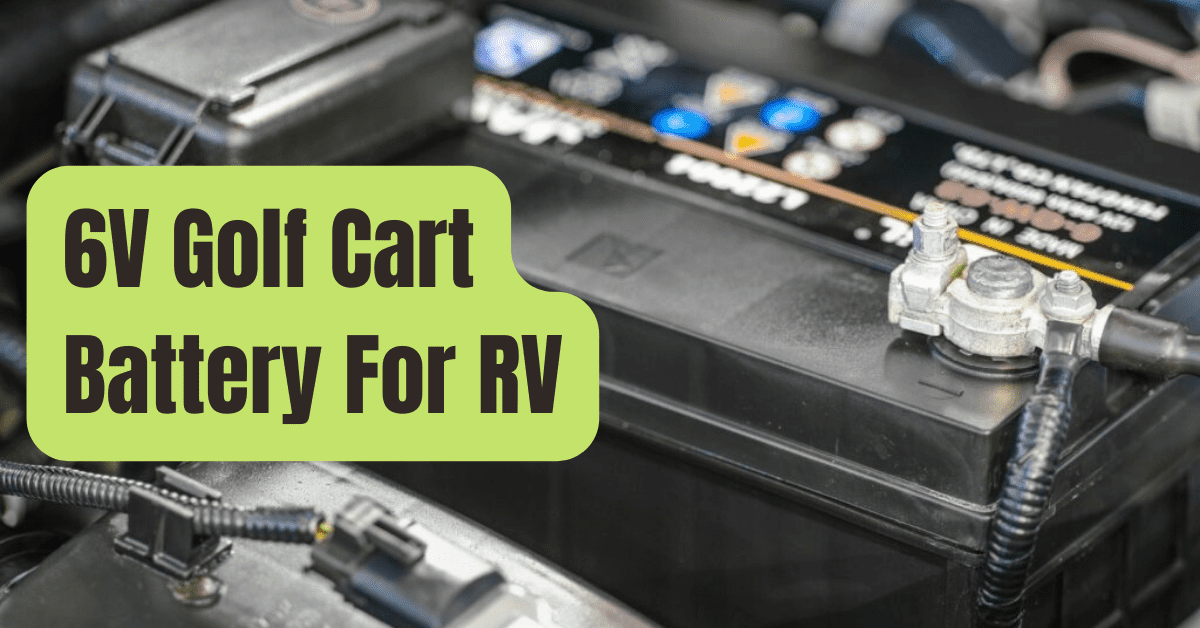RVs can function and even be pleasant for days without connections thanks to batteries.
You may flush the toilet, take a shower, and use your lights as long as you have charged RV batteries and water in the fresh tank.
If your RV has a power converter, RV Batteries can also power 110V/120V gadgets like your TV.
The majority of RV manufacturers do not include the finest batteries with new RVs, which is unfortunate since even the greatest batteries do not last forever.
Even worse, the majority of RV manufacturers use low-quality, single-stage chargers for battery converters.
Because of this, the majority of RV owners have dead batteries within the first two years of ownership, and sometimes much earlier.
I’ll describe the different battery kinds and how RV batteries operate in this post.
I’ll also demonstrate our battery configuration and discuss my decision to use Trojan T-105 6V golf cart batteries.
I’ll go through the essentials, which still amounts to a lot of details.
You should be able to use this article to identify the best battery and converter combination for your RV.
RV Battery Charger/Converter With A Single Stage
I’m going to start by talking about the single-stage battery charger/converter, which is often the root of RV battery issues.
Your RV has a charger/converter if it contains house batteries.
A “smart” charger or 4-stage charger may already be included in nicer and some newer RVs.
Skip this section if that is your RV.
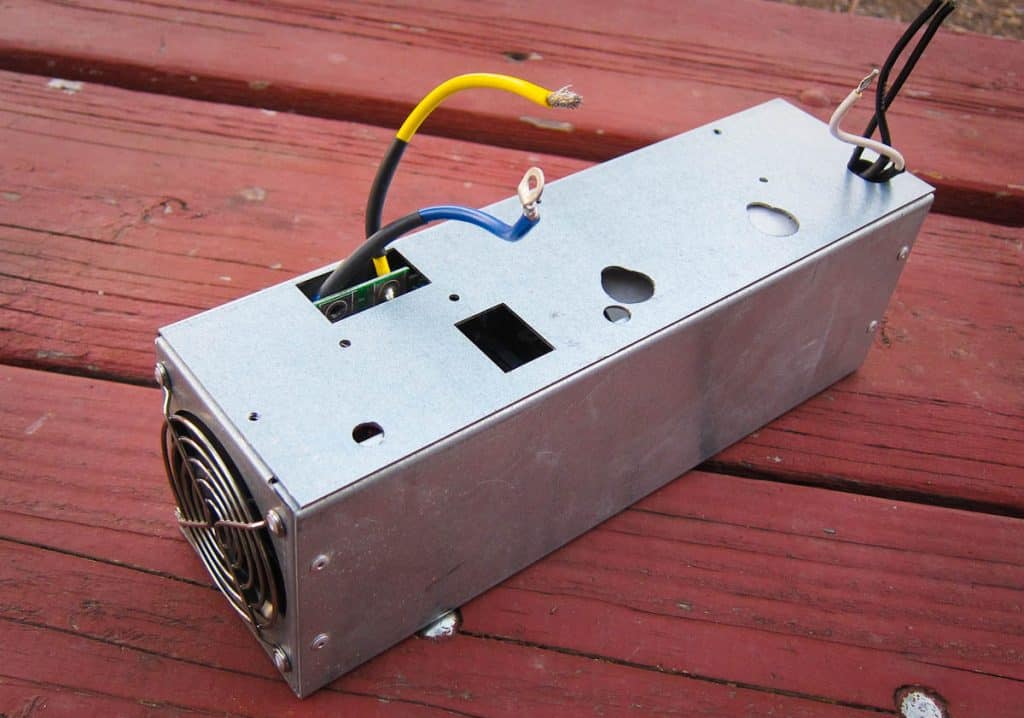
A converter/charger, which transforms 120-volt AC electricity into 12-volt DC power, is a common feature of RVs.
Usually, this device also recharges the batteries inside RVs.
Your 12-volt appliances are powered by the converter when you are hooked into shore power.
This applies to your TV antenna, lights, vent fans, water pump, electric awnings, etc.
“Wait a minute, I thought my batteries did that,” you may be thinking.
However, while connected to shore power, your 12-volt appliances will continue to operate even if you remove your RV’s house batteries.
The converter also uses part of the 12-volt electricity to charge the batteries, which is why it’s often referred to as a converter/charger or battery charger.
The issue is that many factory-installed converters only utilize one fixed voltage, often between 13.6 and 13.8 volts, to maintain and charge RV house batteries.
They are referred to as “one stage” converters/chargers for this reason.
Because batteries charge more quickly, last longer, and perform better when charged by a four step “smart charger,” this is an issue.
The four phases are bulk (14.4V–14.8V), absorption (13.8V–14.2), float (13.2), and finally periodic equalization charge (15.5V) to guarantee that battery sulfation (a poor or decreased battery charge) does not occur.
I’ll go through each step in more detail below.
Batteries that are kept at 13.7V take an eternity to charge, if they ever completely charge at all, and once they are charged, they begin to malfunction.
And I’m not joking when I say cooked.
The charger effectively boils some water out of the batteries, which accelerates the sulfation process and makes maintenance more necessary or causes the batteries to degrade much more quickly than they otherwise would.
Your home batteries will achieve 100 percent capacity without the danger of sulfation or outgassing by beginning with a hefty bulk charge, transitioning to an absorption charge when the battery is around 80 percent full, and finally switching to a float/trickle charge at 95 percent full.
Additionally, they’ll charge considerably more quickly (particularly the first 80%) and last a lot longer.
Last but not least, maintaining the batteries at a 13.2V float charge keeps them cooler and as a consequence they need less upkeep (water & terminal cleaning).
Additionally, this avoids oversulfation, which is the cause of any lead acid battery’s demise.
RV Generators & Battery Charger /Converter Issue
Attempting to charge their batteries while operating the generator is another problem that many RVers have.
You can obtain a respectable charge (85%) in a couple of hours if you use a smart charger (below).
It is costly and often useless to attempt to charge your batteries by using the generator if your RV has a single-stage converter, like ours did.
Without a smart converter’s higher voltage bulk (14.8V) and absorption (14.2V) stages, it takes significantly longer to charge the batteries from a steady 50% drain at 13.7 Volts.
Upgrade to a smart converter charger if you want to boondock and use your RV generator to charge your batteries.
The 4-Stage Smart Battery Charger/Converter is the Solution.
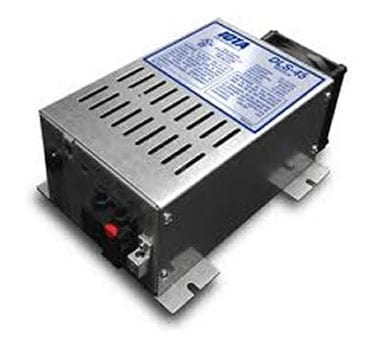
I immediately changed our single stage converter with an IOTA-DLS45 4-Stage Smart Converter/Charger after updating our batteries.
We were informed as novice RVers that we would typically need to purchase a new set of house batteries every year.
House batteries only last one to two years, according to forums I’ve read, and that’s “just the way it is.”
Actually, the issue is with the single-stage battery charger/converter used in the majority of RVs.
Our Trojan T105 batteries should last seven to ten years using an appropriate four-stage smart converter/battery charger, like our IOTA.
As battery life varies somewhat depending on usage, care, and the number of charge cycles, I’ve heard of Trojan batteries lasting even longer in certain cases.
In addition, we don’t have to worry about running out of power since our batteries function as intended.
Imagine being able to watch a movie before bed without being concerned about the heater’s blower’s ability to operate all night.
Or whether the toilet will flush in the morning since the water pump operates on home batteries.
Now that I’ve installed our Trojan T-105 Batteries and Iota Smart Charger Converter, that is the norm for us.
In the meanwhile, I read daily accounts of individuals having trouble with partially charged or undercharged batteries.
If your batteries have been consistently undercharged or mistreated by a single-stage converter, you may need to replace them.
If the batteries still don’t retain a charge after changing the charger converter, I suggest replacing the batteries.
Should You Purchase Which Smart Charger Converter?
The choice between Iota and Progressive Dynamics’ smart battery charger converters is a question of taste.
I picked the IOTA DLS45 since IOTA units cost less and have a smaller footprint.
Matching the amperage of your present battery charger converter is the simplest approach to acquire the “correct” smart charger.
Some folks, who are confused, attempt to match their RV’s line amperage (30amp or 50amp).
Two separate things are being measured by these.
The charging converter is 12V, whereas the RV plug is 110V.
Our 30-amp RV has a 45-amp charging converter because of this.
Below are links to some of the most well-liked smart chargers.
The IOTA that we use is the first connection.
The 55 amp variant is probably used by RVs that are bigger than ours.
What are Battery Amp Hours?
I believe it will be beneficial to discuss battery amp hours before I discuss battery kinds.
The most practical and popular unit of measurement for RV battery storage capacity is amp hours.
Amp Hours (AH) are best understood as the quantities of electricity contained in a battery’s “gas tank.”
The power required to operate a 1 amp electrical pull for 1 hour is 1 amp hour.
For instance: A 0.5 AH LED lightbulb is possible.
3 Amp Hours will be used if 1 LED lightbulb is used for 6 hours (1 x 0.5 x 6 = 3).
A total of 3 Amp Hours will be used by 6 LED light bulbs for 1 hour (6 × 1 x.5).
If our RV batteries had 100AH of capacity, we could operate those 6 lights for slightly over 33 hours before depleting their “tank” (6 x 33.3 x.5 = 100).
Is that clear?
Amp The standard method for calculating hours is the “20-hour rate.” This is computed by 20 hours of equally spaced battery discharge from full charge to empty.
The 20 hour rate represents the entire quantity of electricity delivered during that period.
Why is there a 20-hour difference? Considering that batteries provide more AH when electricity is consumed gradually and less AH when it is used fast.
For a day’s worth of usage, the 20 hours rate works well.
The 20-hour rate’s greatest benefit is that it allows us to compare batteries with ease.
At 20 hours, our Trojan T-105s have a 225AH capacity.
Trojan also produces batteries with a larger capacity.
225AH, in my opinion, is plenty for two persons.
Comparing battery capacity is difficult if the rating is off (1-hour AH rate).
Any battery that doesn’t have a 20-hour AH rating should be avoided.
The Most Prevalent Kinds Of House Batteries For Rvs
Your present batteries will either start to keep a charge once you have a good smart converter/charger, or they won’t.
No huge surprise if they don’t since you’re presumably reading this post because your batteries died in the first place.
To ensure that your next set of batteries won’t meet the same demise as the last set, it was still highly worthwhile to update to a smart converter.
I’ll go through the most typical battery kinds utilized by RVers below.
#1. Lead Acid 12-Volt RV/Marine Flooded Cell Batteries
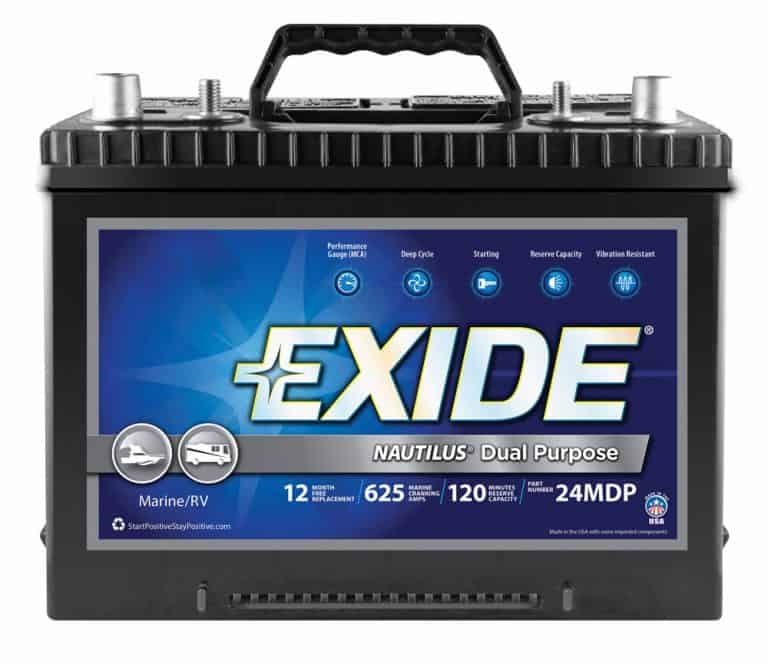
Most RVs have 1 or 2 12V RV/Marine Flooded Cell Batteries when they are brand new.
Although the makers call these batteries “deep cycle,” they are really hybrid starter/deep cycle batteries.
Although it may seem like marketing, pure “deep cycle” batteries can be depleted and recharged more thoroughly than hybrid starter/deep cycle batteries in real-world applications.
Deep cycle batteries often have bigger capacities and last longer as well.
A cheap pair of 12-Volt RV/Marine batteries is a fantastic option for folks who are often hooked into full connections.
The usage of a 4-stage smart charger will still be beneficial for these batteries since it will increase their lifespan and power output.
Golf cart batteries, also known as 6-Volt Deep Cycle Batteries
Deep cycle batteries may be completely recharged after an 80% drain without suffering any harm.
With hybrid RV/marine batteries, don’t do that!
#2. Golf Cart Application Is Intended For 6-volt Deep Cycle Batteries.

These batteries are heavy-duty workhorses that can withstand a lot of damage and survive for a very long time.
These are the batteries I advise if you travel often, boondock, and live off-hookups full-time or most of the time.
Our Trojan T105 Batteries are 6V golf cart batteries that I purchased and then connected in series to form a single, sizable 12-volt battery.
It should be noted that 6V batteries must be used with an even number of cells.
You cannot connect three or five of them to produce the required 12-Volts.
#3. AGM Batteries in the 12- or 6-Volt range
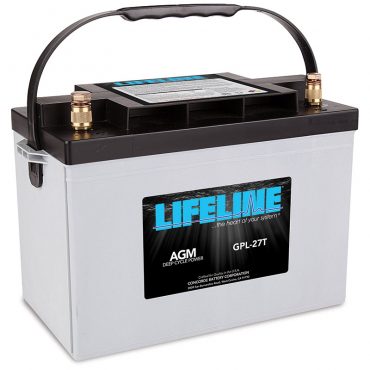
The acid is liquid in ordinary lead-acid battery cells.
The acid electrolyte solution is kept immobilized in AGM and other VRLA (valve regulate lead acid) batteries by soaking a fiberglass mat in it (Absorbed Glass-Mat batteries), or by converting the liquid into a paste-like gel by adding silica and other gelling chemicals (gel batteries).
Overall, this has a largely positive and sometimes negative impact.
The advantage of AGM batteries over conventional flooded cell batteries is their superior charge retention.
If you plan to keep your RV for many months at a time, I advise AGM batteries.
During storage, AGM batteries deplete relatively gradually.
As a result, you won’t need to bother about charging the batteries in your RV while you’re between travels.
In the winter, I’d still take them out and trickle charge them, but even then, they’ll only need to be recharged occasionally, as opposed to every few weeks with flooded lead acid.
The drawback of AGM batteries is that they cost around twice as much as conventional flooded cell batteries.
When comparing batteries with equivalent Amp-Hour capacities, an AGM weighs more than a flooded cell battery.
Finally, AGM batteries cannot be opened, examined, or filled.
AGM batteries still outgas, thus they won’t last as long as well maintained flooded cell batteries.
They are also known as “Valve Regulated Lead Acid” batteries for this reason.
When pressure builds up in the battery as a result of overcharging or rapid discharge, they contain a valve that enables outgassing (electrolysis).
Any gases that are released cannot be replenished since the batteries are sealed.
#4. Lithium-Ion Batteries (LiFePO4)
I can’t comment to their application in the actual world since we don’t have lithium batteries.
In comparison to lead acid batteries, lithium iron phosphate batteries have several advantages, including quicker charging, more capacity per unit of size and weight, more reliable power output, greater depth of discharge, and more recharge cycles (longevity).
Unless you boondock often and depend on Solar Power Lithium batteries, they are not a practical or cheap alternative for most RVers.
Unfortunately, lithium batteries are also about 10-times more costly than equivalent lead acid batteries – or 5-times more expensive than AGM batteries.
I suggest reading the Technomads Lithium Battery Page if you’re interested in learning more about lithium batteries for RVs.
What Types of Batteries Are Ideal For Your RV?
For the majority of RVers, AGM Batteries are the best choice.
I make this statement mainly because most folks don’t need another maintenance task (must fill/charge the RV batteries) taking up mental space.
Most RVers travel seldom.
6-Volt flooded cell (Golf Cart) batteries are the ideal option for full-timers, boondockers, those who prefer to keep an eye on and repair things, and people who want the most value for their money.
Use affordable 12V RV/Marine batteries if you never leave the campground.
You actually only need one if the power goes out and you never leave the RV park.
Our Power System
I had been aware for some time that our batteries weren’t retaining much charge, but it took a storm in Blaine, Washington that downed power lines for us to prioritize a battery update.
Our lights started to fade by 9 o’clock the first night following the storm despite using just 100% battery power – not good!
Additionally, we planned an RV vacation to the Mt.
Lassen Volcanic National Park, where we knew we’d be away from connections for a few days.
We had to get new batteries.
The good news is that I had been wanting to replace our batteries for a while since we wanted to do more boondocking (camping outside of developed campgrounds, so no hookups).
Additionally, we’d want to spend more time off-grid camping and in state and national parks.
Two 12-Volt RV/Marine “Deep Cycle” batteries from NAPA were installed in our RV when it was manufactured.
Most RVs use RV/Marine batteries because they are affordable.
On the dealer lot, they’ll do the job, but I wouldn’t count on them to stay.
The house batteries for our RV are situated in a vented compartment beneath the step.
Only two batteries can fit, but given the size of our RV and how much electricity we need, two cells are more than enough for us.
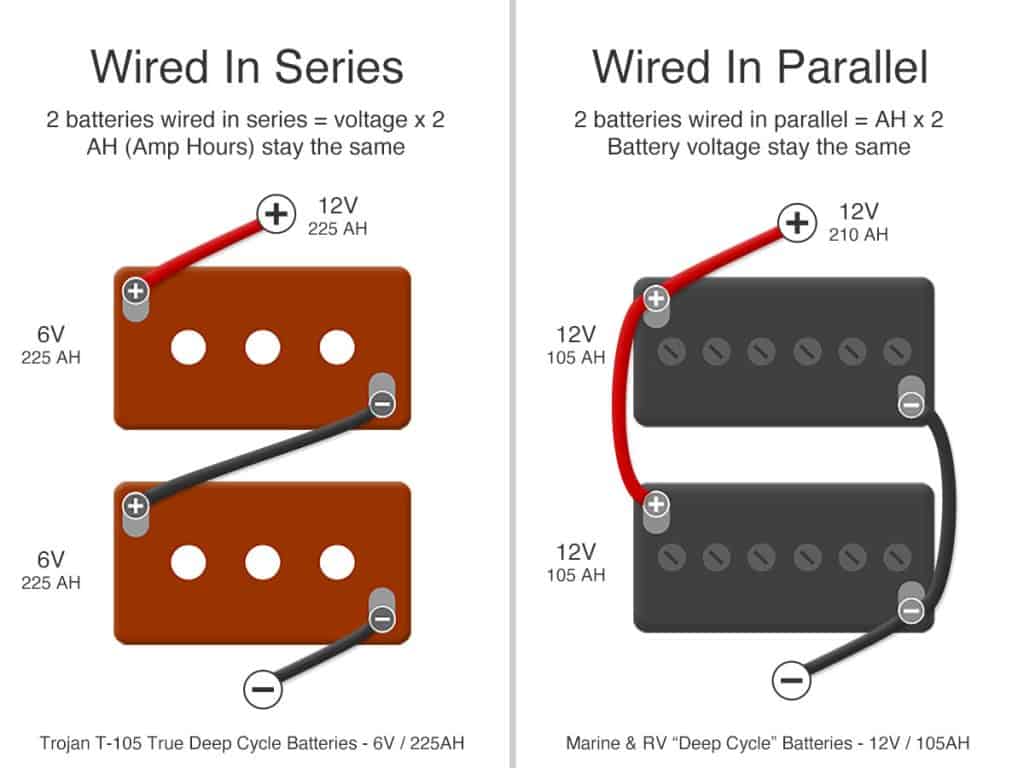
After determining that I could fit two Trojan T-105 Batteries in the available space, I measured the area and proceeded to Battery Systems of Bend, Oregon, to purchase two new Trojans.
The best location to get fresh batteries is at a reputable battery store.
You’ll save money by buying locally since it is often highly costly to ship anything as hefty as a battery.
Correctly wiring 6V batteries is crucial.
This figure, which I created, shows how to connect 6V batteries properly in comparison to 12V batteries.
I purchased the DLS-45 IOTA Smart Charger and installed it in lieu of our single-stage converter charger to make sure our new Trojan batteries would last a long time.
Unfortunately, I didn’t record this; nevertheless, because every configuration is unique, I doubt it would have been very helpful.
Lead-Acid Battery Operation
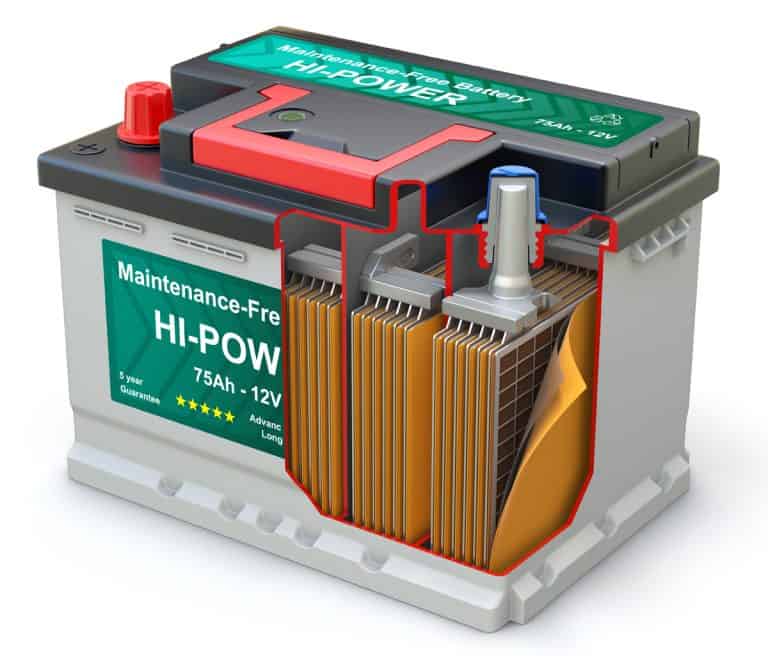
A lead-acid battery of some kind is used by the great majority of RVs.
This covers both flooded cell (the most prevalent) and AGM (Absorbed Glass Mat) batteries, both of which are widely used.
A sort of sealed lead-acid battery is even your engine starting batteries.
The diluted acid is liquid in traditional lead-acid cell batteries.
They are known as “flooded” or “wet” cell batteries for this reason.
The lead-acid chemistry of AGM batteries is identical to that of conventional batteries, but the acid electrolyte solution is immobilized either by soaking a fiberglass mat in it (absorbed-glass-mat batteries) or by transforming the liquid into a paste-like gel by adding silica and other gelling agents (gel-cell batteries).
Two lead plates (electrodes) are suspended in sulfuric acid in lead acid batteries (electrolyte).
To be completely correct, the positive plate is lead dioxide, whereas the negative plate is lead.
Lead and acid in the battery undergo a chemical process that results in lead sulfate and water when power is drawn from the battery (discharge).
Lead sulphate and water are converted back into lead, lead dioxide, and acid when the battery is recharged.
Your battery undergoes one “charge cycle” for each time you fully discharge it before recharging it.
Batteries can only be charged so many times before they start to lose their effectiveness.
Older batteries don’t maintain a charge as effectively as fresh batteries do for this reason.
Keep Your RV House Batteries Safe!
Several hundred cycles of discharge and recharge are intended for RV house batteries.
However, there are three things you can do to significantly shorten the lifespan of your batteries:
Charge The Battery Completely – Batteries will lose their ability to retain a charge if they are totally discharged even once.
Batteries may sometimes only be partially dead.
In certain circumstances, a trickle charger may be able to gently revive them.
A battery is often considered permanently dead and has to be replaced if the voltmeter reading is 10.5 volts.
Not Fully Charged or Not Charged Frequently Enough – Lead and acid combine to create sulphate when batteries are depleted.
When the battery is charged, sulphate is quickly converted back into lead, lead dioxide, and acid from its initial state as a sludge.
The sulphate progressively hardens and crystalizes on the positive and negative plates if the battery is depleted for an extended period of time (a few weeks or more).
In the near term, this lowers battery capacity, but over time, it destroys the batteries.
The majority of RVs use subpar battery charger converters or neglect to properly maintain their batteries, making this the leading cause of early battery death in RVs.
Letting Batteries Dry Out – Not adding water is another simple method to ruin a set of lead acid batteries.
Because of the vents, lead acid batteries won’t blow up while outgassing (electrolysis).
Outgassing may result from either overdischarge (using a 12V battery at a high drain) or overcharging using a subpar converter or charger.
Lead acid batteries include vents to let out water vapor and extra gases while they are outgassing.
Regular replacement of this lost water is required.
To work, the lead plates must be immersed.
Your batteries will soon expire if the plates are exposed to air.
RV Battery Maintenance
Batteries perform best when their terminals are clean, they are completely charged, and they are full of acid.
As a result, they must constantly be kept completely charged and filled.
That also implies they should never be partly charged or depleted of water or acid while being kept.
This is so because sulfation is an adversary of your battery life.
Lead sulfate, which is only present when your batteries aren’t fully charged, is what causes this.
Lead sulfate damages your batteries in two ways because it solidifies on the battery plates and doesn’t dissolve again.
This won’t be a problem as long as your batteries are charged.
The only maintenance required if you use AGM batteries is charging them and keeping the terminals free of debris.
Golf cart batteries are flooded lead-acid batteries, therefore they need periodic watering and routine charging.
Cleaning Battery Terminals
Having the proper equipment makes cleaning battery terminals simple.
You just need a terminal cleaning brush, a ratchet set, and perhaps some vaseline.
What is the substance that collects on your battery connections, first of all? Both the positive and negative terminals have a tendency to leave behind a powdery residue, however the positive terminal’s is more likely to have blue/green residue and the negative terminal’s to have white.
The greenish blue substance that accumulates on positive battery terminals is copper sulfate.
A reaction between the copper terminal clamp and the lead in the battery, as well as some outgassing from the sulfuric acid in the battery, results in the formation of copper sulfate.
Copper sulfate should be eliminated as it occurs since it is poor at conducting electricity.
Vaseline may be applied in a thin coating to stop it from immediately regenerating.
- On the positive battery terminal, there is copper sulfate.
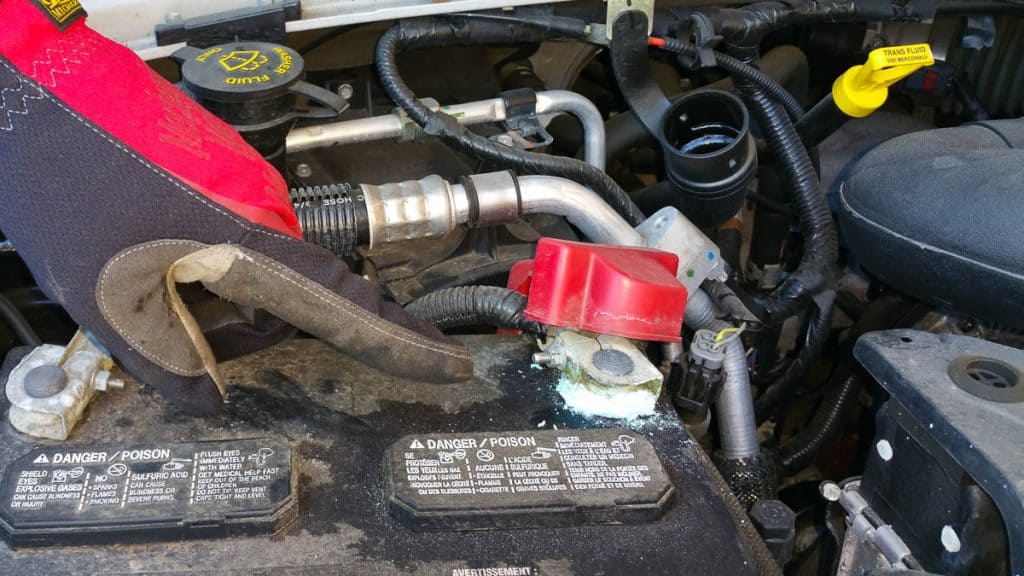
- Use a terminal brush to scrub the terminal.
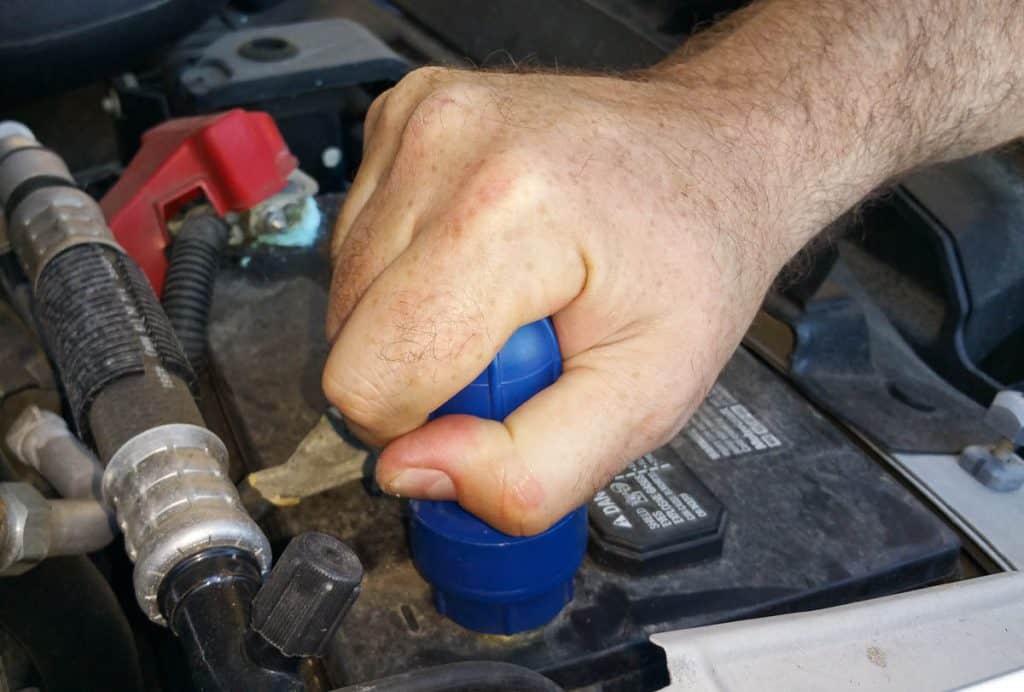
- To clean the terminal connection, use a wire brush.
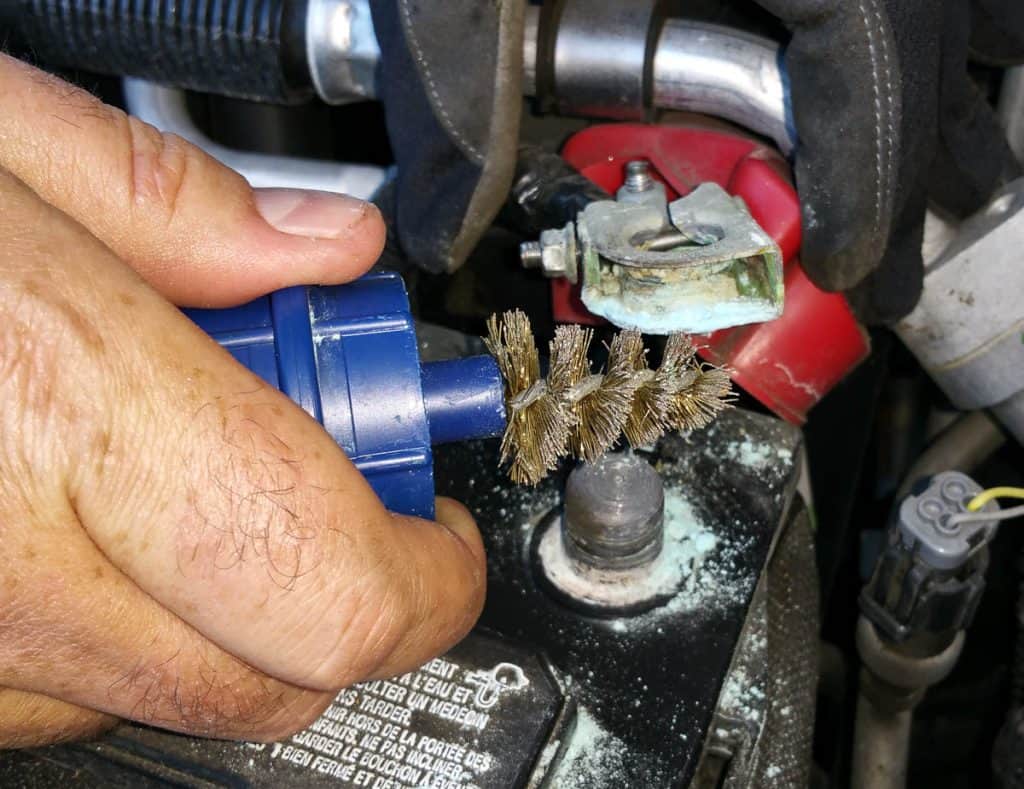
- Lubricate the battery terminal with vaseline.
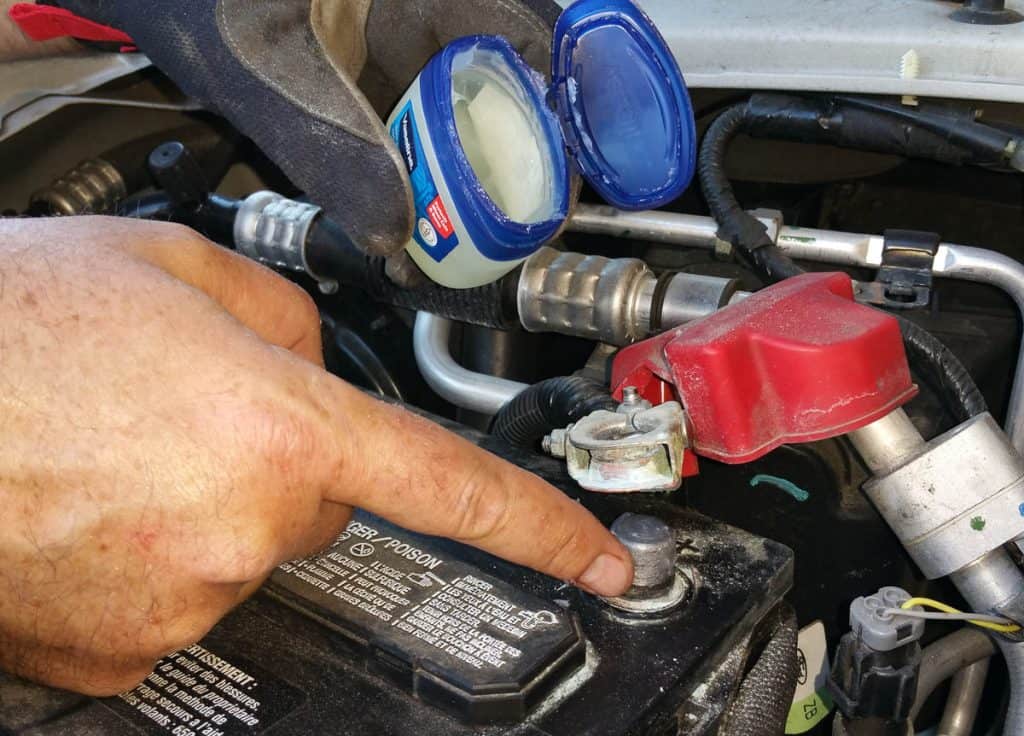
- The battery terminal back on.

The majority of individuals avoid touching battery connections because receiving an electrical shock is unpleasant.
Always unplug the negative battery terminal first for the greatest results.
A terminal clamp should not contact the terminal, therefore check this.
And after that, unplug the positive battery terminal.
You may safely clean the battery terminals after being unplugged.
Simply complete the circuit without touching the positive and negative terminals simultaneously.
Use any tiny wire brush to clean your battery connections if you don’t have a brush specifically designed for that purpose.
I clean battery terminals using a battery terminal brush since it is convenient.
How to Fill RV House Batteries with Water
It’s fairly simple to add water to the house batteries in your RV.
You’ll need batteries syringe filler, distilled water, and around 5 minutes.
Each house battery may hold three (6V) or six (12V) cells.
You just need to unscrew the vent cap to fill battery cells.
Using a screwdriver to open battery cells may be necessary, however Trojan T-105s may be opened by hand.
Important: When adding water to batteries, ONLY use purified water.
Since distilled water lacks electrolytes (salt), it cannot interact with the battery’s acid and lead plates.
Most retailers sell distilled water in the water department.
Normally, battery cells should be filled to 1/8 inch below the lip’s bottom.
There is no need to measure; just fill the tube until it is almost reaching the bottom.
Just make sure you fully charge each battery, that’s all.
Use a battery filler to make sure the water gets into the battery.
It resembles a large turkey baster.
Squeeze the bulb, insert the tube into the gallon of distilled water, fill the bulb to the top, and then pour the remaining water into a battery cell.
A Conclusion
This is just a shallow dive into a big topic.
By no means did I cover everything! Please post any inquiries in the comments section, and I’ll get back to you or improve this piece.
The next time you consider shopping for RV house batteries, I hope you find this post to be useful.

